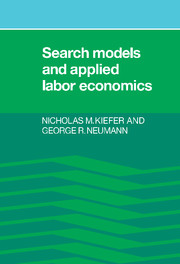Book contents
- Frontmatter
- Contents
- Preface
- 1 Introduction
- Part I Wages, reservation wages, and duration
- Part II Continuous-time models of duration
- Part III Applications
- Part IV Mobility and contracting
- 11 Employment risk and labor market diversification
- 12 A proposition and an example in the theory of job search with hours constraints
- 13 Interfirm mobility and earnings
- 14 Methods for analyzing employment contracts and other agreements
- Index
12 - A proposition and an example in the theory of job search with hours constraints
Published online by Cambridge University Press: 06 October 2009
- Frontmatter
- Contents
- Preface
- 1 Introduction
- Part I Wages, reservation wages, and duration
- Part II Continuous-time models of duration
- Part III Applications
- Part IV Mobility and contracting
- 11 Employment risk and labor market diversification
- 12 A proposition and an example in the theory of job search with hours constraints
- 13 Interfirm mobility and earnings
- 14 Methods for analyzing employment contracts and other agreements
- Index
Summary
Employment agreements often involve, implicitly or explicitly, far more than the posting and acceptance of a wage rate. This chapter considers the optimal behavior of a worker choosing among jobs characterized by wage–hour pairs. The usual analysis of worker behavior characterizes jobs by wages alone and typically assumes that the worker is free to adjust hours freely, given the wage. The assumption of continuously adjustable hours seems extreme, given the many jobs requiring shifts of fixed length. The model studied here is the other extreme. Jobs have associated wages and hours; workers can adjust hours only by changing jobs. Other characteristics of jobs are undeniably important as well – working conditions, fringe benefits, and pensions, to name a few. These could be incorporated into the structure used here. For the present I take the view that hours are probably the most important job characteristic after wages, so for simplicity I will concentrate on hours and wages. This chapter also concentrates attention on worker behavior; optimizing behavior by firms is suppressed, as is the discussion of equilibrium. On the other hand, the model is specifically empirically oriented – it delivers, with additional functional form assumptions, a likelihood function suitable for use with micro data on turnover. No error term need appear mysteriously in an “empirical section.” The model is stochastic from the outset.
This chapter concentrates on two labor market states, employment and nonemployment, which for convenience will frequently be referred to as unemployment.
Information
- Type
- Chapter
- Information
- Search Models and Applied Labor Economics , pp. 236 - 246Publisher: Cambridge University PressPrint publication year: 1989
Accessibility standard: Unknown
- 1
- Cited by
